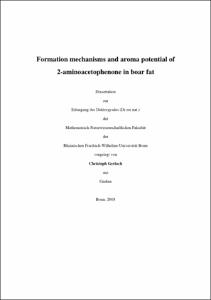Gerlach, Christoph: Formation mechanisms and aroma potential of 2-aminoacetophenone in boar fat. - Bonn, 2019. - Dissertation, Rheinische Friedrich-Wilhelms-Universität Bonn.
Online-Ausgabe in bonndoc: https://nbn-resolving.org/urn:nbn:de:hbz:5n-51469
Online-Ausgabe in bonndoc: https://nbn-resolving.org/urn:nbn:de:hbz:5n-51469
@phdthesis{handle:20.500.11811/7831,
urn: https://nbn-resolving.org/urn:nbn:de:hbz:5n-51469,
author = {{Christoph Gerlach}},
title = {Formation mechanisms and aroma potential of 2-aminoacetophenone in boar fat},
school = {Rheinische Friedrich-Wilhelms-Universität Bonn},
year = 2019,
month = mar,
note = {For decades the surgical castration of male piglets has been a common practice to avoid the incidence of boar taint within Europe. Boar taint is known as an offensive off-flavour occurring when meat of uncastrated boars is heated prior to consumption. According to the current state of knowledge the off-flavour’s perception by sensitive consumers is mainly caused by high endogenous concentrations of two substances: The boar pheromone androstenone (5α-androst-16-en-3-one) and the heterocyclic amine skatole (3-methylindole). As the surgical castration of male piglets without anaesthesia is known to cause serious pain and distress for the animals this practice is increasingly questioned and refused by the majority of consumers. Driven by this public concerns, in 2010 all European stakeholders along the production chain of pork voluntarily agreed to ban surgical castration without anaesthesia by the beginning of 2018 and search for alternative strategies to prevent consumers from tainting pork.
Since the formulation of this declaration known as “declaration of Brussels” many efforts have been undertaken in order to minimize the levels of androstenone and skatole in boars, i.e. immunocastration, boar fattening. However, frequent discrepancies between the sensory evaluation of boar fat and analytically determined levels of androstenone and skatole raised the question whether and to what extend other substances contribute to the off-flavour. In this context compounds of miscellaneous classes have been discussed. Indole, like skatole a degradation product of L-tryptophan in the pig’s large intestine, and reduced metabolization products of androstenone, 5α-androsten-ol and 5β-androsten-ol, were proven to have a minor impact on the occurrence of boar taint. Furthermore, fatty acids and their microbiological degradation products as well as phenolic compounds were suggested as additional boar taint agents.
Interestingly, no focus was put on hepatic phase-I-metabolites of skatole although seven products of the hepatic clearance of the amine were already identified almost 20 years ago. Among these metabolites a substance appears, that already attracted attention as a key substance within the origination of off-flavours in white wines and milk products, 2-aminoacetophenone. However, no data about 2-aminoacetophenone levels in boars exist and it’s biogenesis in pigs has not yet been elucidated. Thus, the presented thesis addressed the question of a possible contribution of 2-aminoacetophenone to the perception of boar taint and its formation in pigs.},
url = {https://hdl.handle.net/20.500.11811/7831}
}
urn: https://nbn-resolving.org/urn:nbn:de:hbz:5n-51469,
author = {{Christoph Gerlach}},
title = {Formation mechanisms and aroma potential of 2-aminoacetophenone in boar fat},
school = {Rheinische Friedrich-Wilhelms-Universität Bonn},
year = 2019,
month = mar,
note = {For decades the surgical castration of male piglets has been a common practice to avoid the incidence of boar taint within Europe. Boar taint is known as an offensive off-flavour occurring when meat of uncastrated boars is heated prior to consumption. According to the current state of knowledge the off-flavour’s perception by sensitive consumers is mainly caused by high endogenous concentrations of two substances: The boar pheromone androstenone (5α-androst-16-en-3-one) and the heterocyclic amine skatole (3-methylindole). As the surgical castration of male piglets without anaesthesia is known to cause serious pain and distress for the animals this practice is increasingly questioned and refused by the majority of consumers. Driven by this public concerns, in 2010 all European stakeholders along the production chain of pork voluntarily agreed to ban surgical castration without anaesthesia by the beginning of 2018 and search for alternative strategies to prevent consumers from tainting pork.
Since the formulation of this declaration known as “declaration of Brussels” many efforts have been undertaken in order to minimize the levels of androstenone and skatole in boars, i.e. immunocastration, boar fattening. However, frequent discrepancies between the sensory evaluation of boar fat and analytically determined levels of androstenone and skatole raised the question whether and to what extend other substances contribute to the off-flavour. In this context compounds of miscellaneous classes have been discussed. Indole, like skatole a degradation product of L-tryptophan in the pig’s large intestine, and reduced metabolization products of androstenone, 5α-androsten-ol and 5β-androsten-ol, were proven to have a minor impact on the occurrence of boar taint. Furthermore, fatty acids and their microbiological degradation products as well as phenolic compounds were suggested as additional boar taint agents.
Interestingly, no focus was put on hepatic phase-I-metabolites of skatole although seven products of the hepatic clearance of the amine were already identified almost 20 years ago. Among these metabolites a substance appears, that already attracted attention as a key substance within the origination of off-flavours in white wines and milk products, 2-aminoacetophenone. However, no data about 2-aminoacetophenone levels in boars exist and it’s biogenesis in pigs has not yet been elucidated. Thus, the presented thesis addressed the question of a possible contribution of 2-aminoacetophenone to the perception of boar taint and its formation in pigs.},
url = {https://hdl.handle.net/20.500.11811/7831}
}






